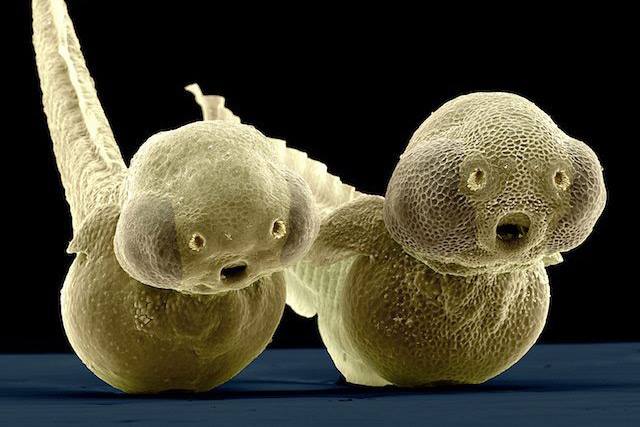The Genome Folding Problem
Associate Professor at MIT Leonid Mirny on the scales of the DNA structure, chromosome interaction, and parall...

These are two-day old zebrafish embryos. The picture was taken using scanning electron microscopy by the researchers from Max Planck Institute for Developmental Biology. The photo won a science photography competition in 2012. The tail, the oral opening, and the olfactory placodes (which look like dots) are clearly seen on the image. At this age the embryos cannot swim. However, they develop very fast on this stage – once fertilized, it takes them three days to hatch. After they hatch, 28 days will pass before they reach pre-reproductive age. It takes another 90 days before they are able to reproduce.
Zebrafish have become a favorite model animal among scientists for a variety of reasons. First, their embryos are easy to observe because they are transparent. Second, they are easy to breed. Third, as explained above, their embryonic development is very fast. But most importantly, zebrafish have an incredible ability to regenerate. At the embryonic stage they can regrow nearly any part of their body, which is especially important if something is damaged during the experiment.

The zebrafish genome is fully sequenced, which makes it easy to manipulate their genes and get potentially interesting results. In addition, zebrafish are vertebrates, so they are fairly close to humans from the point of view of genetics. Therefore, the results of the research on zebrafish may apply to humans as well. For example, zebrafish are widely used in toxicology – the study of toxins and their influence on living organisms. Toxicology is a standard way to test environmental quality.
Biological research is always concerned with living organisms. The first laws of genetics were discovered as a result of studying peas. Population genetics developed from fruit fly experiments. With regard to cloning, everyone knows Dolly the Sheep. Recently the American Health Foundation has analyzed their grant application statistics and saw that the number of zebrafish studies has doubled in less than ten years. Zebrafish are being tested more and more in biomedical research, while the fruit fly — the most common research organism of the past ten years — has become less popular. In some ways, zebrafish are replacing the fruit flies in laboratories. To be fair, one should admit that in the American Health Foundation, the percentage of requests for zebrafish use is around 1.5%, whereas mice are present in around 50% of requests. For biomedical researchers, mammals are more appealing than fish.

Associate Professor at MIT Leonid Mirny on the scales of the DNA structure, chromosome interaction, and parall...

Neuroscientist Karl Friston on the place of cognition in our body and outside it, the way we perceive objects,...

Molecular biologist Greg Towers on the great scientific challenges, the dangers of gene therapy, and the way i...